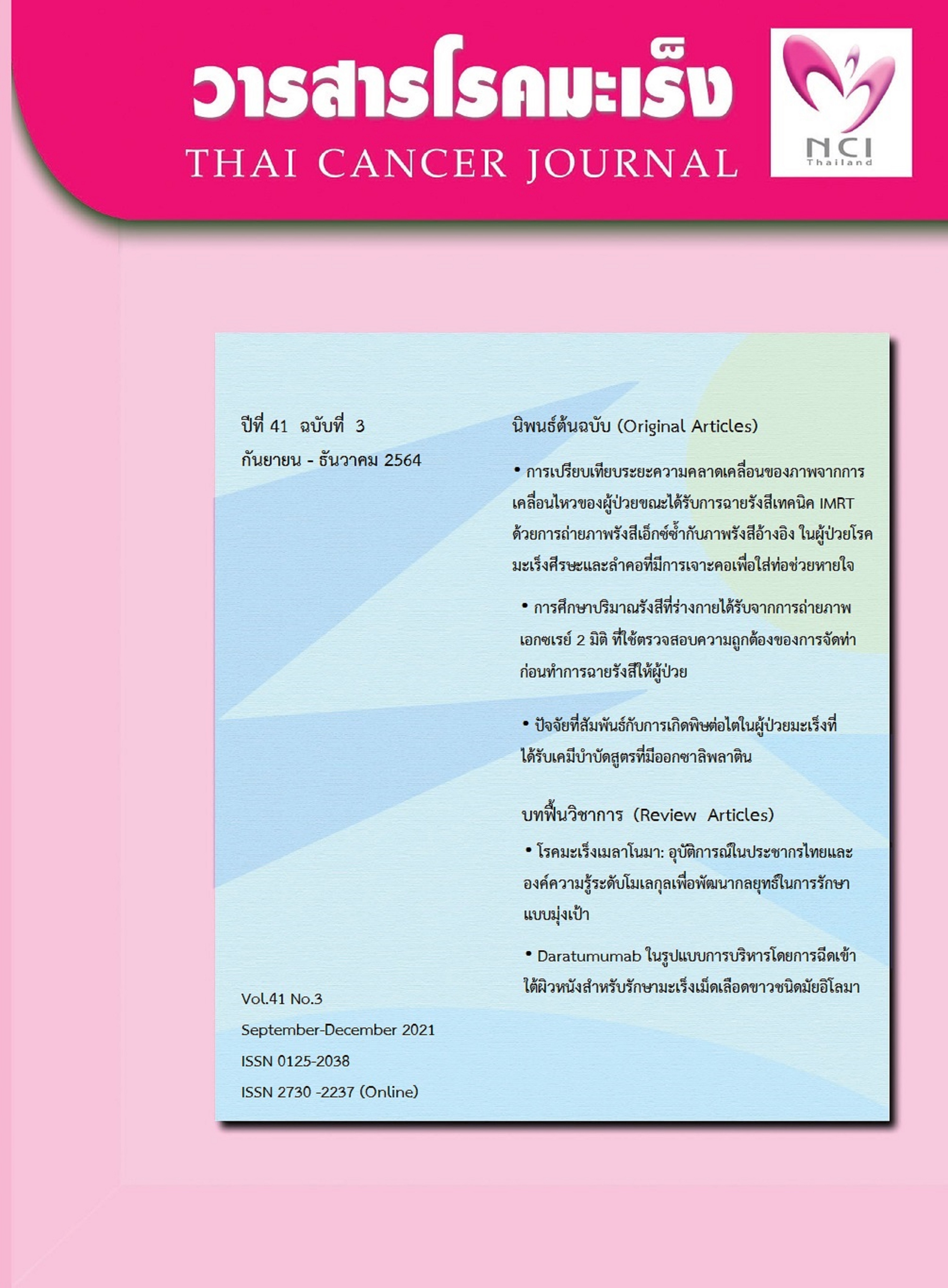Melanoma: Incidence among the Thai population and the use of a molecular understanding of this cancer to improve the strategy of targeted therapy
Abstract
Melanoma is cancer arising from the abnormal growth of melanocytes under the skin layer. There are multifactorial etiologies for melanoma development,especiallythe ultraviolet (UV) derived from daily sunlight, which accelerates DNA damage. Thailand’s geography increases the risk of melanoma among the Thai population. Remarkably, there are a relatively small number of melanoma cases in Thailand, but the mortality rate is high at 48.08%. It is crucial to provide practical prevention guidelines and early diagnosis to fulfill the critical objective of ensuring that patients receive appropriate treatment. This article summarized the evidence on the pathogenesis, risk factors, and especially the molecular mechanism of melanoma development and progression. Ten years of data on the incidence of melanoma among the Thai population during 2010-2019 were collected from the cancer registry of the National Cancer Institute, Department of Medical Services, Ministry of Public Health,Thailand. Remarkably,10-years incidence reveals a continuous registry of new melanoma patients. In addition, this article discussed the basis for targeted therapy of melanoma using molecular target identification. Several in vitro and in vivo studies were reviewed dealing with the use of several gene targeting substances for melanoma treatment, including mutated BRAF targeting by Vemurafenib and Dabrafenib, apoptotic inducing by Veliparib (ABT-888), or correcting the splicing factor dysregulation by SRPIN340 and SPHINX31, which may serve as alternative molecular strategies for melanoma treatment.
References
Khazaei Z, Ghorat F, Jarrahi M, Adineh A, Sohrabivafa M, Goodarzi E. Global incidence and mortality of skin cancer by histological subtype and its relationship with the human development index (HDI); an ecology study in 2018. World Cancer Res J 2019;6(2):e13.
Rastrelli M, Tropea S, Rossi CR, Alaibac M. Melanoma: epidemiology, risk factors, pathogenesis, diagnosis and classification. In Vivo 2014;28(6):1005-11.
McGrath JA, Uitto J. Anatomy and organization of human skin. In: Burns T, Breathnach S, Cox N, Griffiths C. Rook’s Textbook of Dermatology. 8th ed. West-Sussex, United Kingdom: Blackwell Publishing Ltd 2010(1). P. 3.1.
Sanchez J, Subramanian C, Chanda M, Shanguan G, Zhang N, Wang T, et al. Novel C-terminal Hsp90 inhibitor KU758 synergizes efficacy in combination with BRAF or MEK inhibitors and targets drug-resistant pathways in BRAF-mutant melanomas. Melanoma Res 2021;31(3):197-207.
Tanda ET, Vanni I, Boutros A, Andreotti V, Bruno W, Ghiorzo P, et al. Current State of Target Treatment in BRAF Mutated Melanoma. Front Mol Biosci 2020;7:154.
De Braud F, Khayat D, Kroon BB, Valdagni R, Bruzzi P, Cascinelli N. Malignant melanoma. Crit Rev Oncol Hematol 2003;47(1):35 -63.
DeWane E, Kelsey A, Oliviero M, Rabinovitz H, Grant-Kels M. Melanoma on chronically sun-damaged skin: Lentigo maligna and desmoplastic melanoma. J Am Acad Dermatol 2019; 81(3):823-33.
Piao Y, Guo M, Gong Y. Diagnostic challenges of metastatic spindle cell melanoma on fine-needle aspiration specimens. Cancer 2008;114 (2):94-101.
Yde SS, Sjoegren P, Heje M, Stolle LB. Mucosal Melanoma: a Literature Review. Curr Oncol Rep 2018;20(3):28.
Kaliki S, Shields CL. Uveal melanoma: relative ly rare but deadly cancer. Eye 2017;31(2) :241-57.
รังสิมา วณิชภักดีเดชา. มะเร็งผิวหนังชนิด Malignant Melanoma. เข้าถึงได้จาก: https:// wwwsi.mahidol.ac.th/th/healthdetail.asp?aid=1012. สืบค้นเมื่อวันที่ 31 กรกฎาคม 2564.
World health organization. Cancer today. Available at: https://gco.iarc.fr/today/online-analysis-multi-bars. Accessed July 30, 2021.
Imsamran W, Pattatang A, Supattagorn P, Chiawiriyabunya I, Namthaisong K, Wongsena M, et al. Chapter II Cancer Incidence in Thailand. In: Ministry of Public Health and Ministry of Education, editor. Cancer in Thailand Vol.IX, 2013-2015. Bangkok. 2015. p. 40-2.
ข้อมูลทะเบียนมะเร็ง (Cancer registry) พ.ศ.2553-2562 สถาบันมะเร็งแห่งชาติ กรมการแพทย์ กระทรวงสาธารณสุข. เข้าถึงได้จาก: https://www.nci.go.th/th/cancer_record/cancer_rec1.html. สืบค้นเมื่อวันที่ 31 กรกฎาคม 2564.
Li X, Cai M, Wang L, Niu F, Yang D, Zhang G. Evaluation survey of microbial disinfection methods in UV-LED water treatment systems. Sci Total Environ 2019;20:1415-27.
Sample A, He YY. Mechanisms and prevention of UV-induced melanoma. Photodermatol Photoimmunol Photomed 2018;34(1):13–24.
Yang K, Oak A, Slominski R, Brożyna A, Slominski A. Current molecular markers of melanoma and treatment targets. Int J Mol Sci 2020;21(10):3535.
Sitawarin S, Voravud N, Vipakool J. Cutaneous maligmant melanoma. Chula Med J 1998;42(12): 1099-130.
Rissmann R, Hessel MH, Cohen AF. Vemura fenib /dabrafenib and trametinib. Br J Clin Pharmacol 2015;80(4):765–767.
Kuske M, Westphal D, Wehner R, Schmitz M, Beissert S, Praetorius C, et al. Immunomo- dulatory effects of BRAF and MEK inhibitors: Implications for melanoma therapy. Pharmacol Res 2018;136:151-9.
Sharma A, Shah s, Illum H, Dowell J. Vemurafenib: targeted inhibition of mutated BRAF for treatment of advanced melanoma and its potential in other malignancies. Drugs 2012;72(17):2207-22.
Society for Melanoma Research Congress (2019). Available at: https://www.societymelanomaresearch.org/congress. Accessed January 26, 2020.
Ascierto PA, Dummer R, Gogas HJ, Flaherty KT, Arance A, Mandala M, et al. Update on tolerability and overall survival in COLUMBUS: landmark analysis of a randomised phase 3 trial of encorafenib plus binimetinib vs vemurafenib or encorafenib in patients with BRAF V600-mutant melanoma. Eur J Cancer 2020;126:33-44.
Fratangelo F, Camerlingo R, Carriero MV, Pirozzi G, Palmieri G, Gentilcore G, et al. Effect of ABT-888 on the apoptosis, motility and invasiveness of BRAFi-resistant melanoma cells. Int J Oncol 2018;53(3):1149-59.
Gammons MV, Lucas R, Dean R, Coupland SE, Oltean S, Bates DO. Targeting SRPK1 to control VEGF-mediated tumour angiogenesis in metastatic melanoma. British J Cancer 2014;111(3):477-85.
Siriwath J, Wiriyakulsit N, Klomkleang P, Inpad C, Roytrakul R, Kaewkong W. SPHINX31 suppresses splicing factor phosphorylation and inhibits melanoma cell growth and aggressiveness. J Curr Sci Tech 2021;11(3):346-54.
Downloads
Published
Issue
Section
License
บทความทีตีพิมพ์ในวารสารโรคมะเร็งนี้ถือว่าเป็นลิขสิทธิ์ของมูลนิธิสถาบันมะเร็งแห่งชาติ และผลงานวิชาการหรือวิจัยของคณะผู้เขียน ไม่ใช่ความคิดเห็นของบรรณาธิการหรือผู้จัดทํา







